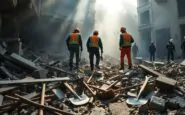Argomenti trattati
In the aftermath of intense Israeli bombardments, Hamas has reached out to the international community for assistance in locating and recovering bodies that remain trapped beneath the debris in the Gaza Strip. The ongoing humanitarian crisis has exacerbated the urgency of this request, as the Palestinian group emphasizes the dire need for heavy machinery to aid in the search efforts.
Recent developments in body recovery efforts
On a recent Friday evening, the armed faction of Hamas, known as the Qassam Brigades, announced the handover of the remains of an Israeli captive. This transfer occurred at 11 PM local time, although Hamas did not disclose the specific location where the body was retrieved from. The group described the remains as belonging to an “occupation prisoner,” implying that it was an Israeli individual rather than one of the diverse captives taken during the conflict initiated on October 7, 2023.
The Israeli military confirmed that the Red Cross was involved in the transfer, stating that a coffin containing the remains was being passed to Israeli authorities. Before any public identification can occur, official confirmation will be provided to the deceased’s family. The Israeli army highlighted the expectation that Hamas should fulfill its commitments regarding the return of all deceased captives.
Hamas’s commitment to the ceasefire agreement
According to Hamas, the group remains dedicated to the terms of the ceasefire agreement mediated by the United States, which includes the return of the bodies of those still unaccounted for under the ruins of Gaza. While Hamas insists it has returned every body it could recover, the group has stated that additional assistance is essential to locate the remaining captives trapped in the rubble.
The emotional impact on Israeli society
The situation surrounding the return of the remains is causing significant emotional turmoil within Israel, as noted by former ambassador Alon Liel. Many Israelis are expressing frustration, believing that Hamas is not fully complying with the ceasefire terms by failing to return all deceased captives. Liel noted the prevailing anger among the public, which is putting pressure on the Israeli government to act decisively.
Hamas has indicated that some remains are located in areas that were previously tunnels or buildings that have been destroyed by Israeli strikes. To recover these remains, they require heavy machinery, which they allege Israel has not permitted into the Gaza Strip. Since much of the heavy equipment was damaged during the conflict, there are very few machines available for Palestinians to clear the extensive rubble.
Challenges in international cooperation
Reports from Al Jazeera suggest that Israel is not cooperating with nations willing to assist in the recovery efforts. For instance, Turkey expressed a readiness to send a team of experts specializing in body retrieval, but Israel has denied access to these experts and the necessary equipment that could facilitate the recovery process.
Continuing humanitarian crisis in Gaza
As efforts continue, two bulldozers were seen working in Hamad City, a district in Khan Younis, where Hamas is actively searching for the remains of captives. This area has been heavily targeted by Israeli forces, leading to the destruction of several apartment buildings. The scale of the devastation is significant; Gaza’s civil defense authorities estimate that over 10,000 Palestinians are still trapped under the debris, with only a small fraction of bodies—280—having been recovered thus far.
In light of these developments, Hamas is urging mediators to facilitate the flow of humanitarian aid into Gaza, expedite the reopening of the Rafah border crossing with Egypt, and initiate reconstruction efforts in the war-torn region. Despite a ceasefire agreement established recently, Israel has yet to permit substantial aid deliveries and maintains military operations in various parts of Gaza, compounding the challenges faced by the local population.

